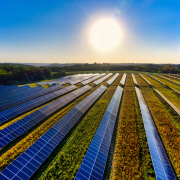AgriSolar News Roundup: Pastureland, Australian Grazing Quality, Regenerative Energy
Pastureland: Solar Panels and Sheep
“Grazing by sheep and other livestock joins other dual uses: planting groundcover to benefit pollinators, growing marketable plants such as cherry tomatoes and lavender under the panels, installing beehives, and maximizing soil health practices to improve the land for later ag use. The use of solar sites for livestock grazing is still in its infancy, but flocks of sheep are already grazing contentedly under and around glass panels in Pennsylvania, Virginia, Maryland, and New York. By welcoming the grazers, solar operators save money on land maintenance. After the cost of leasing the land, vegetation management is often their top expense.” – Bay Journal
Solar Panels Increase Australian Grazing Quality During Drought
“Two agrivoltaic installations in New South Wales, Australia, are being credited with increasing the quantity and quality of fleece in sheep grazing at the facilities during a drought. Research has indicated that the partial shade offered by solar panels creates a microclimate that reduces evaporation and significantly boosts the production of vegetation in arid climates. Researchers found that areas that were partially or fully covered by solar panels increased their biomass production by 90%.” – PV Magazine
Silicon Ranch’s Regenerative Energy Program
“Silicon Ranch founded a branch of its company dedicated to regenerative land management practices nearly four years ago and has found that a forward-looking, natural approach to solar project planning is proving fruitful in the long term. To address degraded soils and topsoil regeneration, Regenerative Energy gathers a seed mix of grasses native to that respective region and re-seeds the site. Given the length of the solar development process, seeds are ideally sown at least one year ahead of construction. Newly rooted plants will reintroduce stability to that soil.” – Solar Power World



